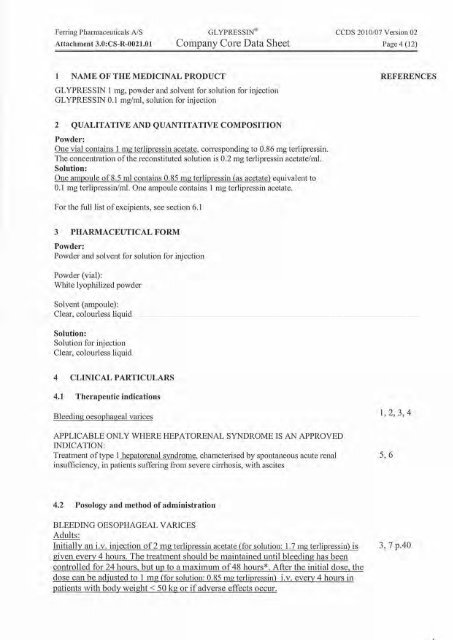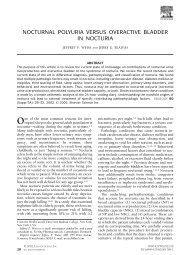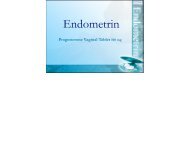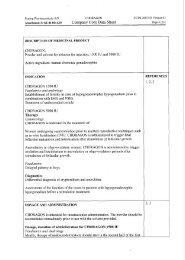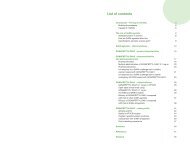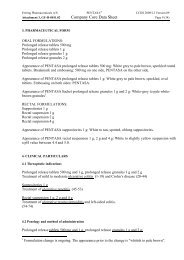Company Core Data Sheet
Company Core Data Sheet
Company Core Data Sheet
You also want an ePaper? Increase the reach of your titles
YUMPU automatically turns print PDFs into web optimized ePapers that Google loves.
FelTing Pharmaceuticals A/SAttachment 3.0:CS-R-0021.01GLYFRESSm®<strong>Company</strong> <strong>Core</strong> <strong>Data</strong> <strong>Sheet</strong>CCDS 2010/07 Version 02Page 4 (12)1 NAME OF THE MEDICINAL PRODUCTGLYPRESSIN 1 mg, powder and solvent for solution for injectionGLYPRESSIN 0.1 mg/ml, solution for inj ectionREFERENCES2 QUALITATIVE AND QUANTITATIVE COMPOSITIONPowder:One vial contains 1 mg terlipressin acetate, conesponding to 0.86 mg terlipressin.The concentration ofthe reconstituted solution is 0.2 mg terlipressin acetate/mI.Solution:One ampoule of8.5 m1 contains 0.85 mg terlipressin (as acetate) equivalent to0.1 mg terlipressin/ml. One ampoule contains 1 mg terlipressin acetate.For the full list ofexcipients, see section 6.13 PHARMACEUTICAL FORMPowder:Powder and solvent for solution for injectionPowder (vial):White lyophilized powderSolvent (ampoule):Clear, colourless liquidSolution:Solution for injectionClear, colourless liquid4 CLINICAL PARTICULARS4.1 Therapeutic indicationsBleeding oesophageal varicesAPPLICABLE ONLY WHERE HEPATORENAL SYNDROME IS AN APPROVEDINDICATION:Treatment oftype 1 hepatorenal syndrome, characterised by spontaneous acute renalinsufficiency, in patients suffering from severe cilThosis, with ascites1,2,3,45,64.2 Posology and method of administrationBLEEDING OESOPHAGEAL VARICESAdults:Initially an i.v. injection of2 mg terlipressin acetate (for solution: 1.7 mg terlipressin) isgiven every 4 hours. The treatment should be maintained until bleeding has beencontrolled for 24 hours, but up to a maximum of 48 hours*.After the initial dose, thedose can be adjusted to 1 mg (for solution: 0.85 mg terlipressin) i.v. every 4 hours inpatients with body weight < 50 kg or ifadverse effects occur.3,7 pAO
Fen-iog Phanllaceuticals A/SAttachment 3.0:CS-R-0021.01GLYFRESSm®<strong>Company</strong> <strong>Core</strong> <strong>Data</strong> <strong>Sheet</strong>CCDS 2010/07 Version 02Page 5 (12)*Other duration of treatment may be approved locally. Consensus statement from the fifthBaveno Congress recommends up to 5 days.APPLICABLE ONLY WHERE HEPATORENAL SYNDROME IS AN APPROVEDINDICATION:In type 1 hepatorenal syndrome:REFERENCES175,6 p.243 to 4 mg of terlipressin acetate (for solution: 2.55-3.4 mg terlipressin) every 24 hours as 3or 4 administrationsIn the absence of any reduction of the serum creatinine after 3 days of treatment, cessationof GLYPRESSIN treatment is advised.In the other cases, GLYPRESSIN treatment is to be pursued until the obtaining either of aserum creatinine less than 130 Idmol/litre or of a drop of at least 30 % in the serumcreatinine with respect to the value measured at the time of diagnosis of hepatorenalsyndrome.The standard average duration oftreatment is 10 days4.3 ContraindicationsContraindicated in pregnancyHypersensitivity to terlipressin or any other excipients of the product.84.4 Special warnings and precautions for useBlood pressure, heart rate and fluid balance should be monitored during treatment. To avoid 7 p. 40local necrosis at the injection site, the injection must be given i.v. Caution should be exercisedin treating patients with hypertension or recognised heart disease. In patients with septic shock 9,10with a low cardiac output terlipressin should not be used.Children and the elderly: Particular caution should be exercised in the treatment of childrenand elderly patients, as experience is limited in these groups.There is no data available regarding dosage recOlmnendation in these special patientcategories.4.5 Interaction with other medicinal products and other forms of interactionThe hypotensive effect of non-selective beta-blockers on the portal vein is increased with 7, p.6terlipressin. Concomitant treatment with medicinal products with a known bradycardic effect(e.g. propofo!, sufentanil) may lower the heart rate and cardiac output. These effects are due to 7, p.23 + app 1reflexogenic inhibition ofcardiac activity via the vagus nerve due to the elevated bloodpressure.
Fen'ing Pharmaceuticals A/SAttachment 3.0:CS-R-0021.01GLYFRESSJN9<strong>Company</strong> <strong>Core</strong> <strong>Data</strong> <strong>Sheet</strong>CCDS 2010/07 Version 02Page 6 (12)4.6 Pregnancy and lactationREFERENCESTreatment with GLYPRESSIN during pregnancy is contraindicated (ref. 4.3 and 5.3).GLYPRESSIN has been shown to cause uterine contractions and increased intrauterinepressure in early pregnancy and may decrease uterine blood flow. GLYPRESSIN may havehannful effects on pregnancy and foetus.Spontaneous abortion and malformation have been shown in rabbits after treatment withGLYPRESSIN.811Information on transfer of GLYPRESSIN to breast milk is insufficient. GLYPRESSIN shouldnot be used in breast feeding women.4.7 Effects on ability to drive and use machinesNo studies on the effects on the ability to drive and use machines have been perfonned.4.8 Undesirable effectsMedORASystem OrganClass COMMON UNCOMMON RARE Not known(cannot beestimated fromthe availableDisorder (10-1%) (1-0.1%) (0.1-0.01 %) dataHyponatraemia if fluid notMetabolismmonitoredNervous system HeadacheTorsade deCardiac Bradycardia Atrial Fibrillation pointVentricular ExtracystolesTachycardiaChest painMyocardial InfarctionFluid overload with pulmonaryoedemaPeripheralVascular vasoconstriction Intestinal ischaemiaPeripheral ischemiaFacial pallorHvoertensionPeripheral cyanosisHot flushesRespiratory Respiratory distress Dyspnoea-Respiratory failureTransient abdominalGastrointestinal cramps Transient nauseaSkin andsubcutaneousPregnancy,puerperium andperinatalconditionsGeneralTransient diarrhoeaTransient vomitinoInjection site necrosisCardiac failureSkin necrosisUterinehypertonusDecreaseduterine bloodflow12
FelTing Pharmaceuticals AJSAttachment 3.0:CS-R-0021.01GLYFRESSrn®<strong>Company</strong> <strong>Core</strong> <strong>Data</strong> <strong>Sheet</strong>CCDS 2010/07 Version 02Page 7 (12)4.9 OverdoseREFERENCESThe reconunended dose (2 mg terlipressin acetate or 1.7 mg terlipressin /4 hours) should notbe exceeded as the risk of severe circulatory adverse effects is dose-dependent.5 PHARMACOLOGICAL PROPERTIES5.1 Pharmacodynamic propertiesPhallnacotherapeutic group: Posterior pituitary lobe hOllnones (vasopressin and analogues),ATe code: HO 1B A04.Terlipressin initially has an effect of its own, but is converted by enzymatic cleavage to lysine 13vasopressin. Doses of 1 and 2 mg effectively reduce the portal venous pressure and producemarked vasoconstriction. The lowering ofpOlial pressure and azygos blood flow is dependenton dose. The effect of the low dose is reduced after 3 hours, while haemodynamic data showthat 2 mg is more effective than 1 mg as the higher dose produces a dependable effectthroughout the period oftreatment (4 hours).5.2 Pharmacokinetic propertiesThe pharmacokinetics follows a two-compariment model. It has been found that the half-life is 14approximately 40 min., metabolic clearance is approximately 9 ml/kg/min and the distributionvolume is approximately 0.5 l/kg.The desired concentration of lysine vasopressin in plasma is found initially afterapproximately 30 min. and reaches a peak value of 60 to 120 min. after administration ofGLYPRESSIN. Because of 100% cross-reaction between terlipressin and lysine vasopressin,there is no specific RIA method for these substances.5.3 Preclinical safety dataPreclinical data reveal no special hazard for humans based on conventional studies of singleandrepeat-dose toxicity, and genotoxicity. At dosages relevant to humans, the only effectsobserved in animals were those attributable to the pharmacological activity ofterlipressin. Nopharmacokinetic data are available from animals to compare with humans the plasmaconcentrations at which these effects OCCUlTed, but as the route of administration wasintravenous, a substantial systemic exposure can be assumed for the animal studies.An embryo-fetal study in rats demonstrated no adverse effects of terlipressin, but in rabbitsabOliions OCCUlTed, probably related to maternal toxicity, and there were ossificationanomalies in a small number of fetuses and a single isolated case ofcleft palate.1516, 11No carcinogenicity studies have been performed with terlipressin.


